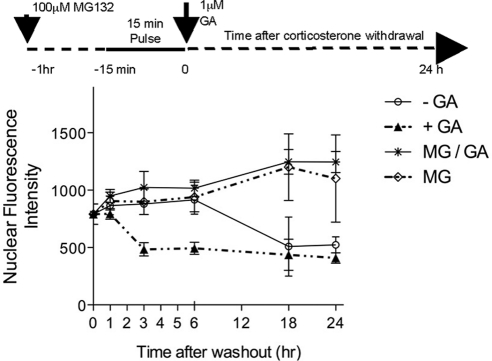Fig. 3.
HSP90 and the proteasome have opposing effects on GR nuclear retention in AtT-20 cells after a single corticosterone pulse. IN Cell 1000 analysis data presented graphically here show time (hours) after ligand withdrawal. The solid trace (open circles) represents corticosterone-treated cells, treated with vehicle after ligand washout. Here, GR was retained in the nucleus for up to 6 h after ligand washout. Clearance from the nucleus then occurred slowly and was complete by 24 h after ligand washout. The dashed trace (filled triangles) represents treatment with 1 μm GA after the 15-min corticosterone pulse was washed from the cells (termed posttreatment). Inhibition of HSP90, after the GC pulse, resulted in an increased rate of clearance of GR from the nucleus. The effect of HSP90 posttreatment was reversed by preincubation of the cells with the proteasome inhibitor MG132; the solid trace (stars) represents preincubation with 10 μm MG132 before the 15-min corticosterone pulse and GA posttreatment. The dashed trace (open diamonds) represents preincubation with 10 μm MG132 before the 15-min corticosterone pulse, in the absence of GA treatment. MG132 appeared to affect both the GA-related, accelerated GR nuclear clearance as well as the slower naturally occurring GR nuclear clearance after hormone withdrawal.

